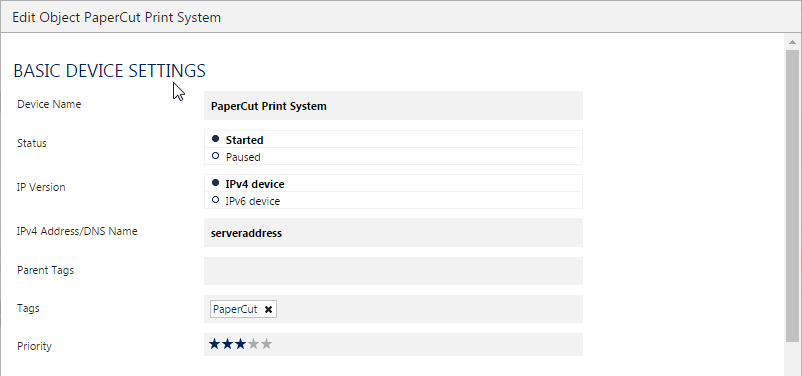Simple Health Monitoring using PRTG
In PaperCut 16.1, we’ve enhanced the Print System Health interface.
Maximize your print uptime by proactively maintaining your print environment using PRTG. You can:
- trigger alarms as soon as outages occur rather than waiting for someone to report an issue
- monitor real-time printing activity to identify changes in printing behavior
- monitor trends in printing resources and usage over time so you can plan for expansion to address bottlenecks before they occur.
- monitor printer and device inactivity
For SysAdmins who have not set up monitoring before, we’ve put together this simple print system monitoring article to take you through the setup.
This method of monitoring provides an Up/Down status by returning HTTP response status codes
- 200 = OK
- 500 = Error
For more information on the types and use of these URLs (endpoints), see the PaperCut manual.
To demonstrate using PRTG Network Monitor and the simple Print System Health interface at a high level, you will set up a sensor to monitor the overall state of your PaperCut Server license. You should get a green [ok] or red [error] status from PRTG once you have finished.
To achieve this you need to complete a few overall tasks:
- Check your server access
- Download and install PRTG on an appropriate server.
- Create a device as a means to group your sensors.
- Create a sensor to monitor a status endpoint of the server.
- Set up notifications.
- Configure the mail server settings in PRTG if needed.
Step One
1. Pick a server in your environment that has network visibility of the PaperCut server you want to monitor.
Put simply, the server needs to be able to successfully access this URL: http://serveraddress:9191/api/health/license/status
If you’re running PaperCut 16.1 or later, the server is online, and you can’t access this URL, check that:
- The hostname can be resolved by your DNS (or that the IP address is correct)
- TCP communications over port 9191 are allowed by your firewall
- The port that the PaperCut server has been configured to use matches the port in the URL
Step Two
1. Download and install PRTG Network Monitor on this server. When done, it should automatically open up its web interface, and start auto-discovering objects in your environment visible over the network.
It may look something like this:

Step Three
Add in a “device”. This will help to organize the interface, providing a place to add all the needed sensors. Either:
- Identify your PaperCut server in this structure,
or - if the server has not been auto-detected, click Add Device to manually add it.
In the screenshots below, the network device (components PRTG discovers on your network) has been removed to make it cleaner to look at for this walk through.
1. Right-click “127.0.0.1”; then select Add Device from the menu.

2. Give the new device a descriptive name, and provided the relevant IP Address/DNS Name for reaching it.

Now you have added the device, it should look like this:

Step Four
Time to add in a sensor so we can point it at the license status URL.
1. Click your server.
2. Click “Add Sensor”.
This is where you configure the particular element you want to monitor.
3. In the Search box at the top of the page, enter HTTP to filter the list of available sensor types down to the one you want.

4. Click Add this to open the sensor settings dialog.
5. In Sensor Name, enter a name for your sensor.
6. In URL, add the endpoint to monitor the license status of your server: http://servername:9191/api/health/license/status?Authorization={your Authorisation Key} 7. Click Continue.

Once added, the License Status sensor is gray but don’t despair, that will go away.

After about 60 seconds, if the URL is correct and the server license status is valid, the sensor changes to green.

Step Five
You’re doing well—it’s nearly coffee time, but before then, you had better make sure that if you’re busy doing stuff, your server will let you know that things have got rough.
1. Click on the License Status Sensor
2. Click the Notifications tab.
3. Click Only use the triggers defined below.
4. Click the Add State Trigger button.

5. Set the values to meet your needs. (for the license manager we would recommend at least 10 mins)
Click Save

Step Six
1. Set up your internal email server if you need to.
PRTG has the ability to email you the notification above directly “out of the box”, however if you want to use your own internal SMTP server:
2. Click the Setup tab.
3. Select System Administrator → Notification delivery.

4. In SMTP Delivery Mechanism, select Use SMTP relay server.
5. Enter your SMTP server settings in the following fields:
*SMTP Relay Server
*SMTP Relay SMTP Port
*SMTP Relay Authentication
6. Adjust other fields as needed

You can test the new email server settings by pushing a test notification:
Click Setup → Account Settings →Notifications.
In the Email and push notification to admin section, click Test.

If you don’t receive the test email notification, check the Logs tab to work out what might be wrong with your SMTP settings!
Lets see it in action
If you stop the PaperCut service on the server, the sensors switch to a status of ‘Warning’, before moving to a status of ‘Down’.

… and if your notification has been configured correctly, you should receive an email around a minute later.
Using these simple informative alarms should allow you to get instant warnings for any major issues that might arise with your print system.
Categories: How-to Articles , Monitoring
Last updated March 15, 2024




Comments